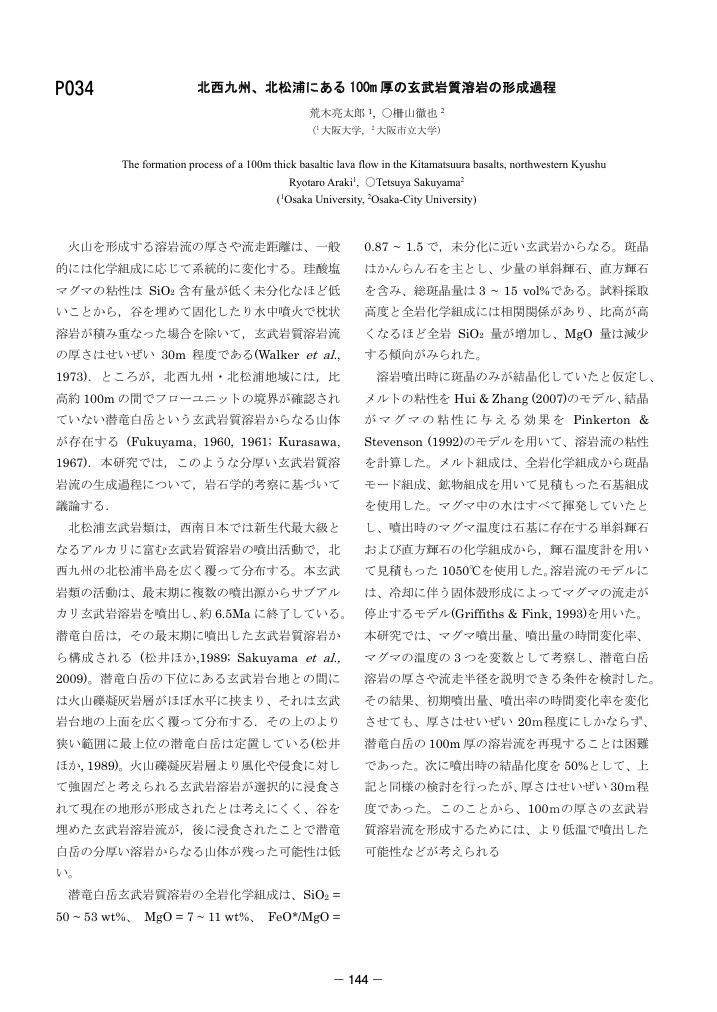7 0 0 0 OA 新生代北部九州のテクトニクス史と火山活動史 ―背弧火山岩区研究における重要性―
- 著者
- 柵山 徹也
- 出版者
- 公益社団法人 東京地学協会
- 雑誌
- 地学雑誌 (ISSN:0022135X)
- 巻号頁・発行日
- vol.119, no.2, pp.224-234, 2010-04-25 (Released:2010-07-06)
- 参考文献数
- 57
- 被引用文献数
- 8 6
Cenozoic western Pacific is characterized by numerous subduction volcanisms, opening of back arc basins, and within-plate volcanisms in backarc regions. These phenomena suggest that thermal disturbances induced by mantle flow caused mantle melting and eruption of magmas in back-arc regions, although diverse modes have been proposed for the mantle condition. To constrain the origin of the magmatism, it is important to clarify both the geodynamics and physicochemical conditions of the mantle in the arc-back arc system. Cenozoic back-arc volcanisms and tectonics in northern Kyushu are key objectives. This paper focuses on the dynamics of the upper mantle in relation to the tectonics of the area. Cenozoic volcanism of the northern Kyushu district is characterized by eruptions of a number of alkaline volcanisms. This volcanic province extends some one hundred kilometers along the Japan Sea coast and includes the Chugoku area. Although the volcanism has been regarded as a large single volcanic province, the northern Kyushu activity is distinguishable from that in Chugoku by geochemical characteristics. Cenozoic basalt volcanism in northern Kyushu occurred mainly in the Tertiary sedimentary basins, which is common to Cenozoic volcanism in the Japan Sea Basin. The sedimentary basin deposits underwent intensive folding with extensive inversion tectonics occurring mainly around the end of Miocene. Studies on dykes and thrust faults also indicate a compressional stress field dominated in northwestern Kyushu during the late Miocene. Initiation of the basaltic activity took place in Kita-Matsuura area and expanded outwards. Basaltic rocks from the Kita-Matsuura are mostly hypersthene-normative and sub-alkalic, whereas rocks from peripheries, such as North Kyushu and Goto Islands, are predominantly less normative-hypersthene and thus are alkalic. From spatial and temporal variations and genetic conditions of basalt magmas, a most plausible source was a small-scale mantle diapir with a potential temperature of more than 1400°C. Combined with an inversion tectonic background after the Japan Sea opening event, the origin of the back-arc magmatism was unrelated to large-scale mantle upwelling. Fluid-fluxed melting of the mantle is not supported by the chemistry. My proposal is active upwelling of a small-scale mantle diapir, probably from the depth of stagnant slab or mantle transition zone.
1 0 0 0 OA 北西九州、北松浦にある100m厚の玄武岩質溶岩の形成過程
- 著者
- 荒木 亮太郎 柵山 徹也
- 出版者
- 特定非営利活動法人 日本火山学会
- 雑誌
- 日本火山学会講演予稿集 2019 (ISSN:24335320)
- 巻号頁・発行日
- pp.144, 2019 (Released:2020-04-13)
1 0 0 0 OA ユーラシア大陸東縁部の新生代背弧域火山活動
- 著者
- 柵山 徹也
- 出版者
- 一般社団法人 日本鉱物科学会
- 雑誌
- 岩石鉱物科学 (ISSN:1345630X)
- 巻号頁・発行日
- pp.120611a, (Released:2013-01-24)

